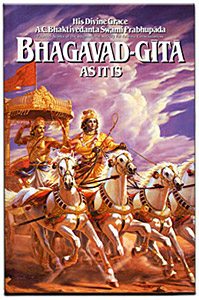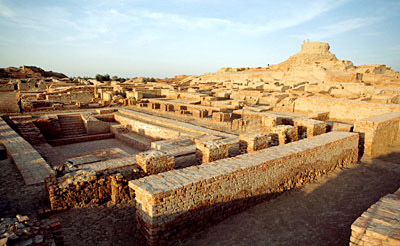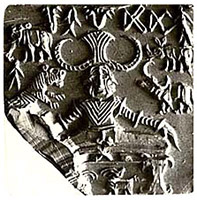The origins of Hinduism lie in two ancient cultural complexes, the Indus valley civilization and the Aryan culture which developed during the second millennium BC. There is some controversy regarding the relationship between these two cultures. The traditional view still supported by some scholars is that the Indus valley civilization declined to be replaced by the culture of the Aryans and spread across the fertile, northern plains which throughout India`s long history, have offered no obstacle to invaders or migrants. The alternative view is that Aryan culture is a development from the Indus valley civilization and was not introduced by outside invaders or migrants; that there is no cultural disjunction in ancient south Asian history, but rather continuity from an early period. Yet, whether the Aryans came from outside the subcontinent or not, Hinduism might be regarded as the development over the next 2,000 years of Aryan culture, interacting with non-Aryan or Dravidian and tribal cultures, though it is Aryan culture which has provided the `master narrative`, absorbing and controlling other discourses.
Hinduism is native to India and historically, it owes its development in India since the Iron Age traditions. It is predominant religion of the Indian subcontinent and is often referred to as Sanatana Dharma, or "the eternal law." Hinduism is the oldest religious tradition and also the oldest living major tradition. Though, actual Origin of Hinduism is not known, yet it is believed that it is formed of diverse traditions and types and has no single founder.
The views and arguments regarding the origins of Hinduism have not been free from ideological interests and the quest for origins itself has been a factor in the development of Hinduism over the last two centuries. Hindu revivalists in the nineteenth century, such as Dayananda Saraswati, looked to Hinduism`s Aryan past to imbue it with new moral impetus and the search for origins has been important for Indology as a scholarly articulation and justification for colonialism. The quest for origins is also relevant in the contemporary politics of Hinduism, which traces continuity between an ancient past and the present, bearing witness to India`s past, Hindu, greatness. As there were no historiography in the south Asian cultural region before the first millennium CE, it was difficult to establish the chronology of Indian religions.
 One of the cliches about Hinduism has been that it is a historical and sees time as cyclic rather than linear, which has militated against the keeping of accurate historical records. Within India, as elsewhere, the record of the past has reflected the concerns of the present, though any historical awareness has been embedded in myths, biographies of people in authority (the charita literature), in genealogies of families and in histories of ruling families in specific locations. Myths and genealogies have been recorded particularly in the Hindu Epics and texts called Indian Puranas, reaching their present form in the mid first millennium BC. A particularly striking text, part of the Vamsavali genre, more concerned with historicity than with mythology, is the `History of the Kings of Kashmir`, the Rajatararigini composed during the twelfth century by Kalhana. This records the genealogies of the kings and brief descriptions of their exploits.
One of the cliches about Hinduism has been that it is a historical and sees time as cyclic rather than linear, which has militated against the keeping of accurate historical records. Within India, as elsewhere, the record of the past has reflected the concerns of the present, though any historical awareness has been embedded in myths, biographies of people in authority (the charita literature), in genealogies of families and in histories of ruling families in specific locations. Myths and genealogies have been recorded particularly in the Hindu Epics and texts called Indian Puranas, reaching their present form in the mid first millennium BC. A particularly striking text, part of the Vamsavali genre, more concerned with historicity than with mythology, is the `History of the Kings of Kashmir`, the Rajatararigini composed during the twelfth century by Kalhana. This records the genealogies of the kings and brief descriptions of their exploits.
In examining the roots of Hinduism the rhetoric of origins should be taken for consideration. Indeed, the very quest for an `origin` may suggest an `essence` which is highly problematic. It is important to bear in mind that the formation of Hinduism, as the world religion, has only occurred since the nineteenth century, when the term was used by Hindu reformers and western orientalists. Moreover, Hinduism is not purely the construction of western orientalists attempting to make sense of the plurality of religious phenomena within the vast geographical area of south Asia, as some scholars have maintained, but that Hinduism is also a development of Hindu self-understanding; a transformation in the modern world of themes already present. The nineteenth-century Hindu reformers speak of Hinduism as the eternal religion or law (sanatana dharma), a common idea among modern Hindus today in their self-description.
The historical root of the Origin of Hinduism goes back ancient times. In addition to that, according to scholars, Hinduism may have evolved in three periods. During the period 6500 BCE-1000 AD, in the ancient times seers assembled together to note down religious texts. There are a lot of controversies among the scholars about the origin of Hinduism. According to the traditional view the origin of Hinduism dates back to around 3000 BCE. On the other hand, some other modern scholar state that the Hindu religion was originated between 3500 and 5000 BCE. The earliest literature of Hinduism is made up of the four Vedas: the Rig-Veda, Sama-Veda, Yajur-Veda and the Atharva-Veda. The Rig-Veda is the oldest scripture. History puts that these texts were composed between 1500 and 800 BC. It is believed that these literatures gradually were transmitted by oral tradition until the advent of the Pallava and Gupta period. In the medieval starting from 1000-1800 AD, and the modern from 1800 AD to present, these sacred literatures came to be known as Hindu religious texts. These texts have been passed by a combination of written and oral tradition since then.
 Origin of Hinduism can also be traced with the origin of Indian society; from the fear and respect that man gradually developed. Then human beings realized the power of fire, air, water and earth and the concept of worship came into existence. The earliest known evidence of Hinduism is found in Mohenjodaro and Harappa. Signs of rituals and worship have also been revealed. They were considered to be eternal and the deities appear to be different and independent, they are really facets of the Supreme God.
Origin of Hinduism can also be traced with the origin of Indian society; from the fear and respect that man gradually developed. Then human beings realized the power of fire, air, water and earth and the concept of worship came into existence. The earliest known evidence of Hinduism is found in Mohenjodaro and Harappa. Signs of rituals and worship have also been revealed. They were considered to be eternal and the deities appear to be different and independent, they are really facets of the Supreme God.
Origin of Hinduism can also be traced to the sacrificial religion, Vedism. People following this early religion came to India in the 1500 BC from the Iranian plateau via the Hindukush and mingled with the Indian people. Hindu philosophy has six branches that evolved from about the 2nd century BC to the 6th century, such as Samkhya philosophy, Yoga philosophy, Nyaya philosophy, Vaisheshika philosophy, Mimamsa philosophy and Vedanta philosophy. All the evidences put together proves that Hinduism is not a religion to have an origin. Hinduism has no history, it believes in the present. Hinduism is based on the concept of oneness - `Thou art that.`
The religion of the mature Indus valley culture has to be inferred from the buildings which were most probably temples, stone statues, terracotta figurines and particularly the steatite seals. The state religion seems to have involved temple rituals, perhaps animal sacrifice, and ritual bathing in the `great bath` found in the citadel at Mohenjodaro. This bath is reminiscent of tanks found in later Hindu temples and reflects a concern with ritual purification through water, an important idea in Hinduism. At Kalibangan a ritual area has been found in which animal sacrifice seems to have been practiced and seven `fire altars` have been located. Indeed, the brick platforms by the great bath at Mohenjodaro may have served a similar purpose.
The large number of female terracotta figurines unearthed during the excavations, may have been goddess images and the presence of the goddess in later Hinduism may be traced back to this early period. It is, of course, impossible to say whether there is continuity in the cult of the goddess from this early age, and the fact that the goddesses are the focus of worship in the Indus culture does not necessarily mean that these are the forerunners of the Hindu goddesses. Goddess worship and the central concerns of fertility seem to have been common in the ancient world and the Harappan goddess or goddesses may have more in common with Sumerian than with later Hindu deities.
 Perhaps suggestive of the later religions are the images on the remarkable steatite seals, particularly the `Pasupati` seal, of a seated figure surrounded by animals, either horned or wearing a headdress. As per the scholars, this figure is a prototype of the Hindu Lord Shiva, the yogin and Lord of the animals (pasupati), sometimes represented with three faces, and the posture with the knees out and feet joined has been interpreted as evidence of yoga in pre-Aryan culture.
Perhaps suggestive of the later religions are the images on the remarkable steatite seals, particularly the `Pasupati` seal, of a seated figure surrounded by animals, either horned or wearing a headdress. As per the scholars, this figure is a prototype of the Hindu Lord Shiva, the yogin and Lord of the animals (pasupati), sometimes represented with three faces, and the posture with the knees out and feet joined has been interpreted as evidence of yoga in pre-Aryan culture.
However, there are a number of linguistic and iconographic continuities between the Indus valley civilization and south Indian, Dravidian forms of Hinduism. The South Indian god Murugan, the young man identified with the god of war, Skanda, is represented in the Indus valley script. It is tempting to speculate that there are continuities of religion from the Indus valley into Hinduism, which would make the roots of the religion go back a very long way. The ritual bath, the fire altars, the female figurines, the horned deities and the `lingas` are certainly suggestive of later Hindu traditions. However, ritual purity, an emphasis on fertility, sacrifice, and goddess worship are common to other religions of the ancient world as well. Indeed, the steatite image of a figure battling with lions is more reminiscent of the Mesopotamian Gilgamesh myth than anything found in later Hinduism.
The Indus valley civilization seems to have declined rather suddenly between 1800 and 1700 BCE, primarily due to environmental causes such as flooding or a decrease in rainfall. A squatter`s period continued for some time after this and smaller Indus valley towns and villages survived the abandonment of the large cities. At Mohenjodaro a number of skeletons were found where they had fallen, the victims of a violent death. It has been claimed that these deaths were caused by early Aryan invaders. The most commonly accepted theory to date has been that Hinduism is the consequence of incursions of groups known as Aryans into the northern plains of India from central Asia, via the mountain passes of Afghanistan, around 1500 BCE. Some of these groups went into Iran and there are close affinities between the Iranian religion of the Avesta (the sacred scripture of Zoroastrianism) and the religion of the Veda. This narrative has maintained that the Aryans were of the same stock as groups which went west into Europe. Aryan culture slowly spread to the Deccan and was established in south India by around the sixth century CE. Thus the Indo-European-speaking Aryans are contrasted with the indigenous, Dravidian-speaking descendants of the Indus valley civilization whom they conquered. Knowledge of the Aryans comes mostly from their sacred text the Rig Veda Samhita, the earliest literature of Hinduism.
Contemporary Hinduism cannot be traced to a common origin, so the discussion is directed towards whether Hinduism fits the river model or, to extend the metaphor, whether the term `Hinduism` simply refers to a number of quite distinct rivers. While these models have restricted use in that they suggest a teleological direction or intention, the river model would seem to be more appropriate in that it emphasizes the multiple origins of Hinduism. The many traditions which feed in to contemporary Hinduism can be subsumed under three broad headings: the traditions of brahmanical orthopraxy, the renounced traditions and popular or local traditions. The tradition of brahmanical orthopraxy has played the role of `master narrative`, transmitting a body of knowledge and behaviour through time, and defining the conditions of orthopraxy, such as adherence to Varnasrama-dharma.









